Spatiotemporal Variation of China’s State-Owned Construction Land Supply from 2003 to 2014
Abstract
:1. Introduction
2. Materials and Methods
2.1. Materials
2.2. Methods
2.2.1. Construction Land Supply Centroid Model
2.2.2. Newly Increased Construction Land Dependence-Degree Index (NCD)
2.2.3. Hotspots Analysis
2.2.4. Two-Way Fixed Effect Model
3. Results and Discussions
3.1. Spatiotemporal Variation of CLSA
3.2. Spatiotemporal Variation of NCSA
3.3. Position and Movement of CLSA and NCSA Geographic Centroids
3.4. Spatiotemporal Variation of NCD
3.5. Analysis of Socio-Economic Driving Factors
4. Conclusions
Acknowledgments
Author Contributions
Conflicts of Interest
References
- Seto, K.C.; Fragkias, M.; Güneralp, B.; Reilly, M.K. A meta-analysis of global urban land expansion. PLoS ONE 2011, 6, e23777. [Google Scholar] [CrossRef] [PubMed]
- Bhatta, B. Analysis of urban growth pattern using remote sensing and GIS: A case study of Kolkata, India. Int. J. Remote Sens. 2009, 30, 4733–4746. [Google Scholar] [CrossRef]
- Abdullah, S.A.; Nakagoshi, N. Changes in landscape spatial pattern in the highly developing state of selangor, peninsular Malaysia. Landsc. Urban Plann. 2006, 77, 263–275. [Google Scholar] [CrossRef]
- Liu, L.; Xu, X.; Chen, X. Assessing the impact of urban expansion on potential crop yield in China during 1990–2010. Food Secur. 2014, 7, 33–43. [Google Scholar] [CrossRef]
- Wei, Y.P.; Zhang, Z.Y. Assessing the fragmentation of construction land in urban areas: An index method and case study in Shunde, China. Land Use Policy 2012, 29, 417–428. [Google Scholar] [CrossRef]
- Osman, T.; Divigalpitiya, P.; Arima, T. Driving factors of urban sprawl in giza governorate of greater cairo metropolitan region using ahp method. Land Use Policy 2016, 58, 21–31. [Google Scholar] [CrossRef]
- Liu, J.Y.; Zhan, J.Y.; Deng, X.Z. Spatio-temporal patterns and driving forces of urban land expansion in China during the economic reform era. Ambio 2005, 34, 450–455. [Google Scholar] [CrossRef] [PubMed]
- China Statistical Yearbook (2003). Available online: http://www.stats.gov.cn/tjsj/ndsj/yearbook2003_c.pdf (accessed on 21 September 2016).
- Liu, Y.; Wang, L.; Long, H. Spatio-temporal analysis of land-use conversion in the eastern coastal China during 1996–2005. J. Geogr. Sci. 2008, 18, 274–282. [Google Scholar] [CrossRef]
- Tan, M.H.; Li, X.B.; Lu, C.H. Urban land expansion and arable land loss of the major cities in China in the 1990s. Sci. Chin. Ser. D-Earth Sci. 2005, 48, 1492–1500. [Google Scholar] [CrossRef]
- Xie, H.; Zou, J.; Jiang, H.; Zhang, N.; Choi, Y. Spatiotemporal pattern and driving forces of arable land-use intensity in China: Toward sustainable land management using emergy analysis. Sustainability 2014, 6, 3504–3520. [Google Scholar] [CrossRef]
- Ding, C.R. Land policy reform in China: Assessment and prospects. Land Use Policy 2003, 20, 109–120. [Google Scholar] [CrossRef]
- Jiang, X.U.; Yeh, A.; Fulong, W.U. Land commodification: New land development and politics in China since the late 1990s. Int. J. Urban Reg. Res. 2009, 33, 890–913. [Google Scholar]
- Zou, Y.; Zhao, W.; Mason, R. Marketization of collective-owned rural land: A breakthrough in Shenzhen, China. Sustainability 2014, 6, 9114–9123. [Google Scholar] [CrossRef]
- Jiang, G.; Ma, W.; Qu, Y.; Zhang, R.; Zhou, D. How does sprawl differ across urban built-up land types in China? A spatial-temporal analysis of the Beijing metropolitan area using granted land parcel data. Cities 2016, 58, 1–9. [Google Scholar] [CrossRef]
- Sorace, C.; Hurst, W. China’s phantom urbanisation and the pathology of ghost cities. J. Contemp. Asia 2016, 46, 304–322. [Google Scholar] [CrossRef]
- Tan, R.; Qu, F.; Heerink, N.; Mettepenningen, E. Rural to urban land conversion in China—how large is the over-conversion and what are its welfare implications? Chin. Econ. Rev. 2011, 22, 474–484. [Google Scholar] [CrossRef]
- Tian, L.; Ma, W. Government intervention in city development of China: A tool of land supply. Land Use Policy 2009, 26, 599–609. [Google Scholar] [CrossRef]
- Wu, J.; Gyourko, J.; Deng, Y. Evaluating conditions in major Chinese housing markets. Reg. Sci. Urban Econom. 2012, 42, 531–543. [Google Scholar] [CrossRef]
- Hui, E.C.M.; Wang, Z. Price anomalies and effectiveness of macro control policies: Evidence from Chinese housing markets. Land Use Policy 2014, 39, 96–109. [Google Scholar] [CrossRef]
- Bian, T.Y.; Gete, P. What drives housing dynamics in China? A sign restrictions var approach. J. Macroecon. 2015, 46, 96–112. [Google Scholar] [CrossRef]
- Woo, W.T. The necessary demand-side supplement to China’s supply-side structural reform: Termination of the soft budget constraint. Chin. New Sour. Econom. Growth 2016, 1, 139. [Google Scholar] [CrossRef]
- China Focus: China Eyes Supply-Side Reform for New Growth. Available online: http://news.xinhuanet.com/english/2015-12/22/c_134941921.htm (accessed on 21 September 2016).
- Wang, Z.Y.; Wang, Y.W. Research on the Effect of Macro-Control Policies on the Real Estate in Harbin; China Architecture & Building Press: Beijing, China, 2008; pp. 935–938. [Google Scholar]
- Leishman, C.; Bramley, G. A local housing market model with spatial interaction and land-use planning controls. Environ. Plan. A 2005, 37, 1637–1649. [Google Scholar] [CrossRef]
- Du, J.; Peiser, R.B. Land supply, pricing and local governments’ land hoarding in China. Reg. Sci. Urban Econ. 2014, 48, 180–189. [Google Scholar] [CrossRef]
- Hui, E.C.M.; Leung, B.Y.P.; Yu, K.H. The impact of different land-supplying channels on the supply of housing. Land Use Policy 2014, 39, 244–253. [Google Scholar] [CrossRef]
- Lin, X.; Wang, Y.; Wang, S.; Wang, D. Spatial differences and driving forces of land urbanization in China. J. Geogr. Sci. 2015, 25, 545–558. [Google Scholar] [CrossRef]
- Du, X.; Jin, X.; Yang, X.; Yang, X.; Zhou, Y. Spatial pattern of land use change and its driving force in Jiangsu province. Int. J. Environ. Res. Publ. Health 2014, 11, 3215–3232. [Google Scholar] [CrossRef] [PubMed]
- Kuang, W.; Liu, J.; Dong, J.; Chi, W.; Zhang, C. The rapid and massive urban and industrial land expansions in China between 1990 and 2010: A clud-based analysis of their trajectories, patterns, and drivers. Landsc. Urban Plann. 2016, 145, 21–33. [Google Scholar] [CrossRef]
- Deng, X.; Huang, J.; Rozelle, S.; Uchida, E. Growth, population and industrialization, and urban land expansion of China. J. Urban Econ. 2008, 63, 96–115. [Google Scholar] [CrossRef]
- Li, X.; Zhou, W.; Ouyang, Z. Forty years of urban expansion in Beijing: What is the relative importance of physical, socioeconomic, and neighborhood factors? Appl. Geogr. 2013, 38, 1–10. [Google Scholar] [CrossRef]
- Liu, Z.J.; Huang, H.Q.; Werners, S.E.; Yan, D. Construction area expansion in relation to economic-demographic development and land resource in the pearl river delta of China. J. Geogr. Sci. 2016, 26, 188–202. [Google Scholar] [CrossRef]
- Kong, W.; Guo, J.; Ou, M. Study on land intensive use response on economic development and regional differentiated control of constructed land. Chin. Popul. Res. Environ. 2014, 24, 100–106. (In Chinese) [Google Scholar]
- Gao, B.Y.; Liu, W.D.; Dunford, M. State land policy, land markets and geographies of manufacturing: The case of Beijing, China. Land Use Policy 2014, 36, 1–12. [Google Scholar] [CrossRef]
- Buxton, M.; Taylor, E. Urban land supply, governance and the pricing of land. Urban Policy Res. 2011, 29, 5–22. [Google Scholar] [CrossRef]
- Peng, L.; Thibodeau, T.G. Government interference and the efficiency of the land market in China. J. Real Estate Financ. Econ. 2012, 45, 919–938. [Google Scholar] [CrossRef]
- Yan, S.; Ge, X.J.; Wu, Q. Government intervention in land market and its impacts on land supply and new housing supply: Evidence from major Chinese markets. Habitat Int. 2014, 44, 517–527. [Google Scholar] [CrossRef]
- China Land and Resources Statistical Yearbook (2004–2015). Available online: http://tongji.cnki.net/kns55/Navi/HomePage.aspx?id=N2015050178&name=YGTTJ&floor=1 (accessed on 21 September 2016).
- China City Statistical Yearbook (2003–2015). Available online: http://tongji.cnki.net/kns55/Navi/HomePage.aspx?id=N2010042092&name=YZGCA&floor=1 (accessed on 21 September 2016).
- Wang, Y.; Chen, Y.N.; Li, Z. Evolvement characteristics of population and economic gravity centers in tarim river basin, uygur autonomous region of Xinjiang, China. Chin. Geogr. Sci. 2013, 23, 765–772. [Google Scholar] [CrossRef]
- He, Y.; Chen, Y.; Tang, H.; Yao, Y.; Yang, P.; Chen, Z. Exploring spatial change and gravity center movement for ecosystem services value using a spatially explicit ecosystem services value index and gravity model. Environ. Monit. Assess. 2011, 175, 563–571. [Google Scholar] [CrossRef] [PubMed]
- Li, Q.; Ren, Z.Y. Energy production and consumption prediction and their response to environment based on coupling model in China. J. Geogr. Sci. 2012, 22, 93–109. [Google Scholar] [CrossRef]
- Li, Z.G.; Liu, Z.H.; Anderson, W.; Yang, P.; Wu, W.B.; Tang, H.J.; You, L.Z. Chinese rice production area adaptations to climate changes, 1949–2010. Environ. Sci. Technol. 2015, 49, 2032–2037. [Google Scholar] [CrossRef] [PubMed]
- Cui, X.G.; Yan, T.L.; Zhu, D.H.; Niu, F.Q.; Zhang, X.D. Applying a gis-based model to collect information on agricultural land-use change in Beijing. J. Agric. Res. 2007, 50, 1073–1081. [Google Scholar] [CrossRef]
- Sen, A.; Smith, T. Gravity Models of Spatial Interaction Behavior; Springer Science & Business Media: Heidelberg, Germany, 2012. [Google Scholar]
- Ord, J.K.; Getis, A. Local spatial autocorrelation statistics: Distributional issues and an application. Geog. Anal. 1995, 27, 286–306. [Google Scholar] [CrossRef]
- Huang, J.; Shen, G.Q.; Zheng, H.W. Is insufficient land supply the root cause of housing shortage? Empirical evidence from Hong Kong. Habitat Int. 2015, 49, 538–546. [Google Scholar] [CrossRef]
- Zheng, S.Q.; Sun, W.Z.; Wang, R. Land supply and capitalization of public goods in housing prices: Evidence from Beijing. J. Reg. Sci. 2014, 54, 550–568. [Google Scholar] [CrossRef]
- He, C.; Huang, Z.; Wang, R. Land use change and economic growth in urban China: A structural equation analysis. Urban Stud. 2014, 51, 2880–2898. [Google Scholar] [CrossRef]
- Zhang, X.L.; Hu, J.; Skitmore, M.; Leung, B.Y.P. Inner-city urban redevelopment in China metropolises and the emergence of gentrification: Case of Yuexiu, Guangzhou. J. Urban Plan. Dev. 2014, 140, 8. [Google Scholar] [CrossRef]
- Lin, G.C.S. The redevelopment of China’s construction land: Practising land property rights in cities through renewals. China Quarterly. 2015, 224, 865–887. [Google Scholar] [CrossRef]
- Qian, J.; Peng, Y.F.; Luo, C.; Wu, C.; Du, Q.Y. Urban land expansion and sustainable land use policy in Shenzhen: A case study of China’s rapid urbanization. Sustainability 2016, 8, 16. [Google Scholar] [CrossRef]
- LI, X.S.; Zhang, S.L.; Wang, Y.H. Quantitative study of construction land increase limit year in the economic transition stage in China. J. Nat. Resour. 2011, 1085–1095. (In Chinese) [Google Scholar]
- Lin, G.C.S.; Yi, F. Urbanization of capital or capitalization on urban land? Land development and local public finance in urbanizing China. Urban Geog. 2013, 32, 50–79. [Google Scholar] [CrossRef]
- Wu, Q.; Li, Y.L.; Yan, S.Q. The incentives of China’s urban land finance. Land Use Policy 2015, 42, 432–442. [Google Scholar]
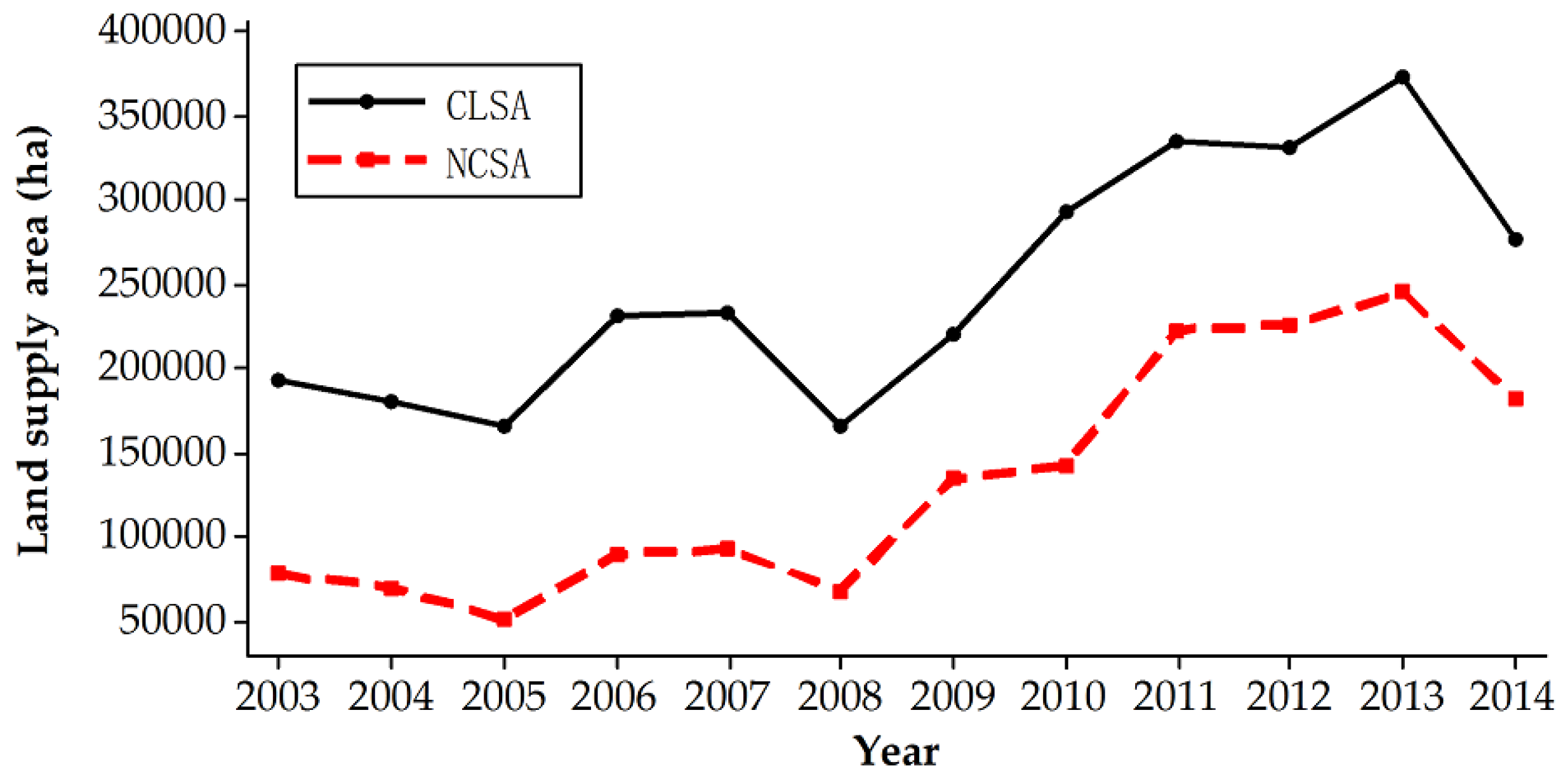
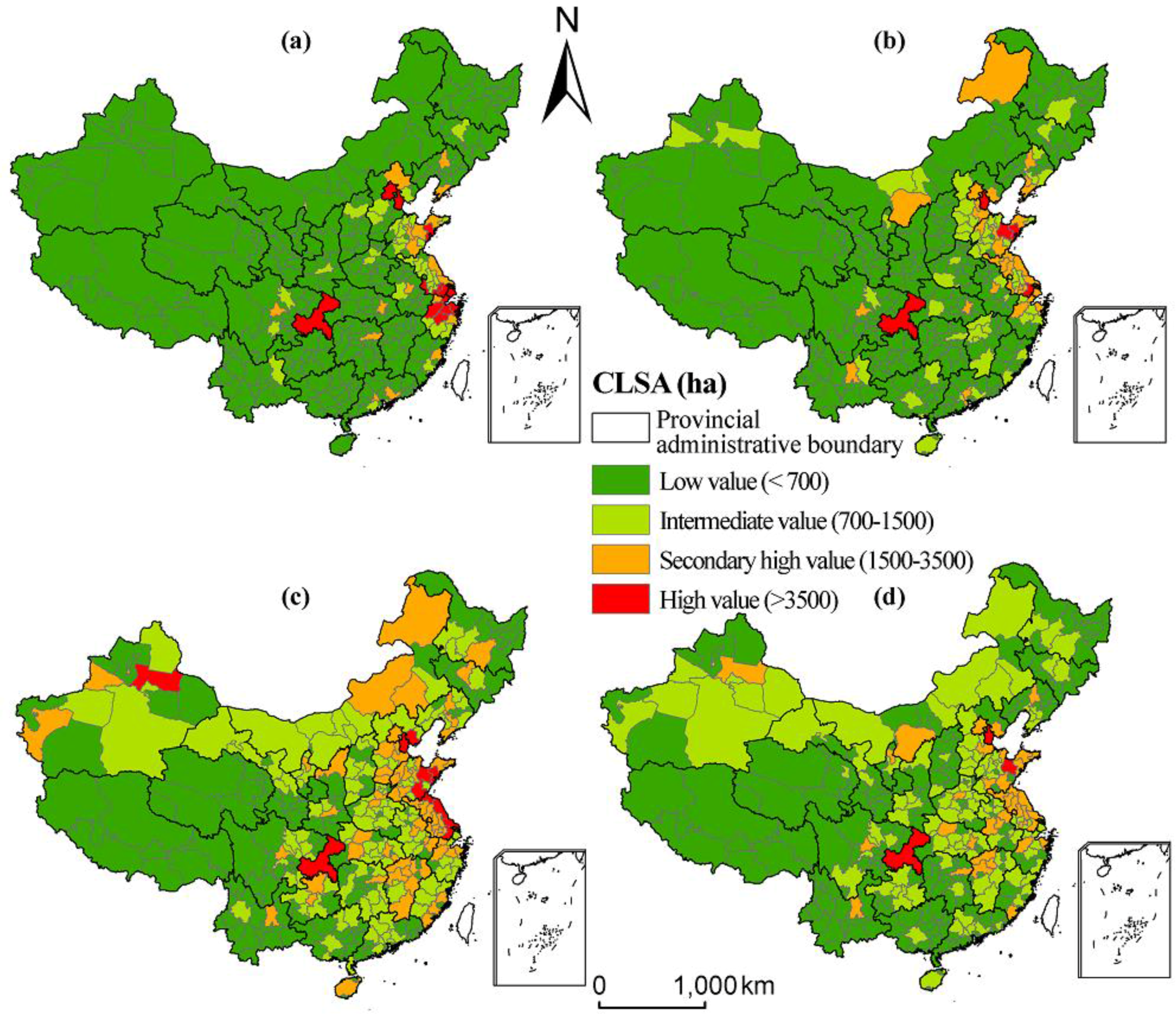

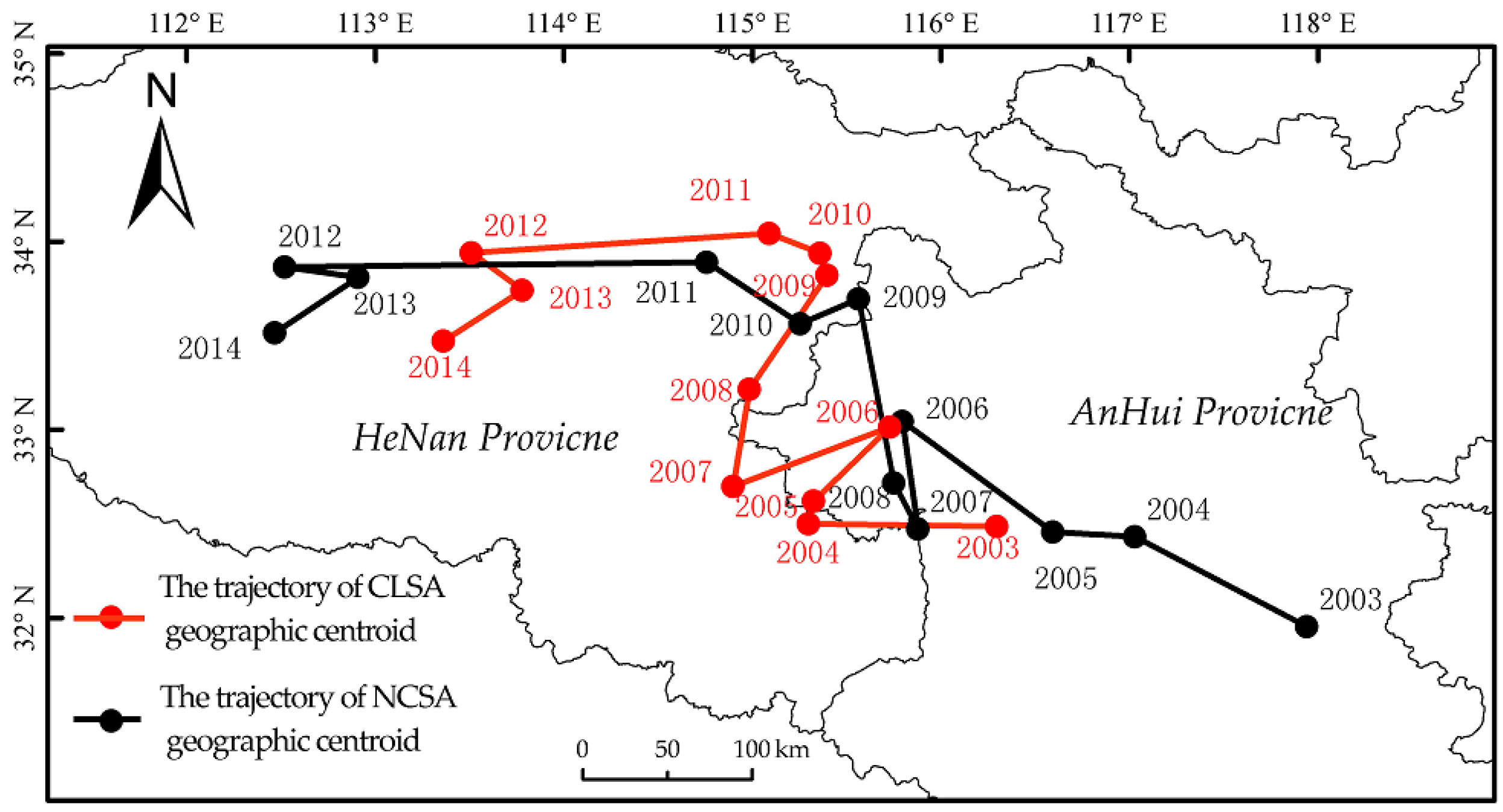
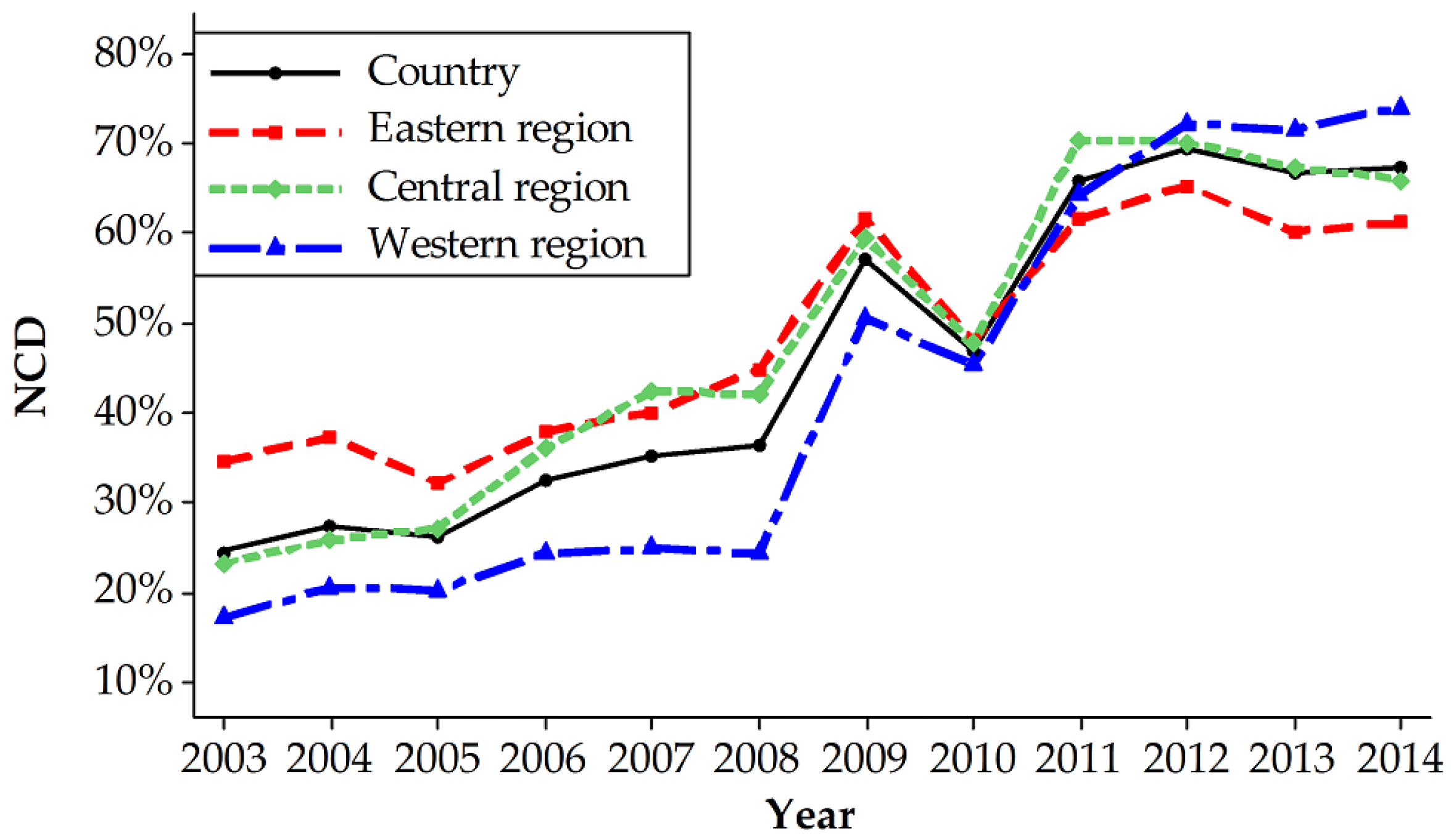
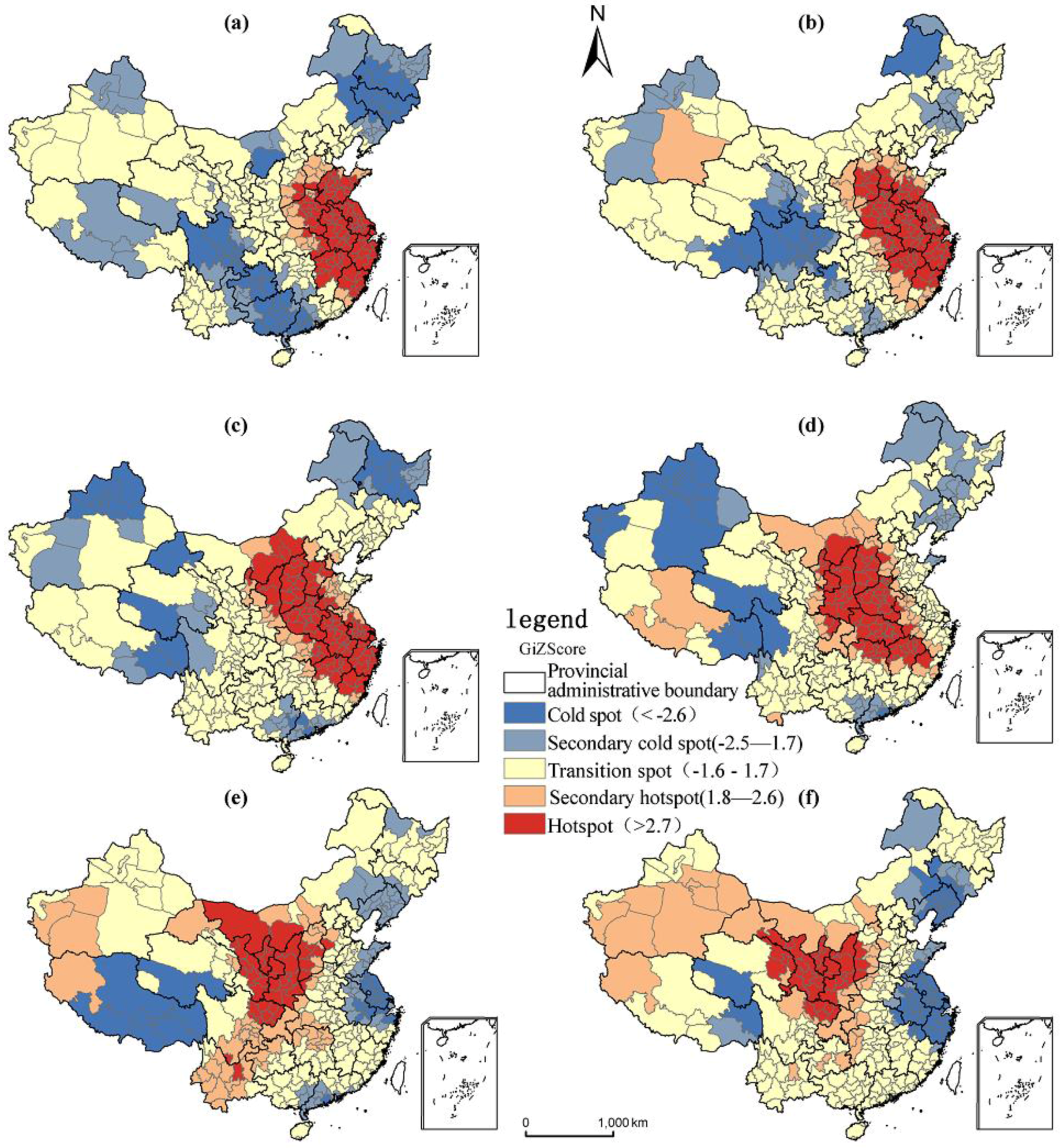
| Year | NCSA | CLSA | ||||||
|---|---|---|---|---|---|---|---|---|
| Longitude | Latitude | Movement Direction | Movement Distance/km | Longitude | Latitude | Movement Direction | Movement Distance/km | |
| 2003 | 116.3 | 32.5 | -- | -- | 117.9 | 32 | -- | -- |
| 2004 | 115.3 | 32.6 | NE | 10.3 | 117 | 32.4 | NW | 9.2 |
| 2005 | 115.3 | 32.5 | SW | 4.3 | 116.6 | 32.5 | SW | 1.2 |
| 2006 | 115.7 | 33 | NE | 9.9 | 115.8 | 33 | SE | 6.9 |
| 2007 | 114.9 | 32.7 | SE | 7.2 | 115.9 | 32.5 | SW | 8.3 |
| 2008 | 115 | 33.2 | NE | 3.3 | 115.8 | 32.7 | NW | 5.9 |
| 2009 | 115.4 | 33.8 | NE | 11.3 | 115.6 | 33.7 | NE | 7.5 |
| 2010 | 115.4 | 33.9 | SW | 2.8 | 115.3 | 33.6 | NW | 1.6 |
| 2011 | 115.1 | 34 | NW | 6.2 | 114.8 | 33.9 | NW | 2.9 |
| 2012 | 113.5 | 33.9 | SW | 18.7 | 112.5 | 33.9 | SW | 13.1 |
| 2013 | 113.8 | 33.7 | SE | 3.5 | 112.9 | 33.8 | SE | 3.6 |
| 2014 | 113.4 | 33.5 | SW | 5.2 | 112.5 | 33.5 | SW | 4.9 |
| Category | Variable | (1) | (2) | ||
|---|---|---|---|---|---|
| CLSA | NCD | ||||
| Coef. | Std.error | Coef. | Std.error | ||
| Economic development level and pattern | lnGDP | 2.081 *** | 0.059 | 0.485 *** | −0.031 |
| ln(GDP)2 | −0.157 *** | −0.006 | −0.035 *** | −0.002 | |
| lnfiv | 0.199 *** | −0.039 | 0.022 * | −0.013 | |
| ratio | −0.112 ** | −0.05 | −0.032 ** | −0.012 | |
| Population growth | lnpop | 0.168 * | −0.097 | −0.05 | −0.034 |
| Living level | lnwage | 0.165 * | −0.097 | −0.002 | −0.007 |
| Time effect factors | yr2004 | −0.019 | −0.024 | 0.011 ** | −0.005 |
| yr2005 | −0.144 *** | −0.034 | −0.030 *** | −0.006 | |
| yr2006 | 0.069 | −0.048 | 0.028 *** | −0.009 | |
| yr2007 | 0.092 | −0.062 | 0.059 *** | −0.011 | |
| yr2008 | −0.281 *** | −0.074 | 0.053 *** | −0.013 | |
| yr2009 | −0.095 | −0.085 | 0.247 *** | −0.016 | |
| yr2010 | 0.189 * | −0.1 | 0.110 *** | −0.018 | |
| yr2011 | 0.286 ** | −0.112 | 0.311 *** | −0.021 | |
| yr2012 | 0.264 ** | −0.12 | 0.321 *** | −0.022 | |
| yr2013 | 0.391 *** | −0.129 | 0.294 *** | −0.024 | |
| yr2014 | 0.057 | −0.136 | 0.290 *** | −0.025 | |
| Cons | −4.025 *** | −1.15 | −1.153 *** | −0.112 | |
| N | 3356 | 3356 | |||
| R2-within | 0.464 | 0.487 | |||
© 2016 by the authors; licensee MDPI, Basel, Switzerland. This article is an open access article distributed under the terms and conditions of the Creative Commons Attribution (CC-BY) license (http://creativecommons.org/licenses/by/4.0/).
Share and Cite
Jiang, M.; Xin, L.; Li, X.; Tan, M. Spatiotemporal Variation of China’s State-Owned Construction Land Supply from 2003 to 2014. Sustainability 2016, 8, 1137. https://doi.org/10.3390/su8111137
Jiang M, Xin L, Li X, Tan M. Spatiotemporal Variation of China’s State-Owned Construction Land Supply from 2003 to 2014. Sustainability. 2016; 8(11):1137. https://doi.org/10.3390/su8111137
Chicago/Turabian StyleJiang, Min, Liangjie Xin, Xiubin Li, and Minghong Tan. 2016. "Spatiotemporal Variation of China’s State-Owned Construction Land Supply from 2003 to 2014" Sustainability 8, no. 11: 1137. https://doi.org/10.3390/su8111137
APA StyleJiang, M., Xin, L., Li, X., & Tan, M. (2016). Spatiotemporal Variation of China’s State-Owned Construction Land Supply from 2003 to 2014. Sustainability, 8(11), 1137. https://doi.org/10.3390/su8111137







